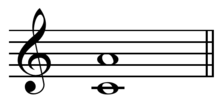- Major sixth
-
major sixth Inverse minor third Name Other names septimal major sixth, supermajor sixth Abbreviation M6 Size Semitones 9 Interval class 3 Just interval 5:3 or 12:7[1] Cents Equal temperament 900 24 equal temperament 900 Just intonation 884 or 933 In classical music from Western culture, a sixth is a musical interval encompassing six staff positions (see Interval (music)#Number for more details), and the major sixth is one of two commonly occurring sixths. It is qualified as major because it is the largest of the two. The major sixth spans nine semitones, its smaller counterpart being the minor sixth, spanning eight semitones. For example, the interval from C to A is a major sixth, as the note A lies nine semitones above C, and there are six staff positions from C to A. Diminished and augmented sixths span the same number of staff positions, but consist of a different number of semitones (seven and ten).
A commonly cited example of a melody featuring the major sixth as its opening is "My Bonnie Lies Over the Ocean".[2]
The major sixth is one of consonances of common practice music, along with the unison, octave, perfect fifth, major and minor thirds, minor sixth and (sometimes) the perfect fourth. In the common practice period, sixths were considered interesting and dynamic consonances along with their inverses the thirds, but in medieval times they were considered dissonances unusable in a stable final sonority; however in that period they were tuned very sharp, to the Pythagorean major sixth of 27/16. In just intonation, the major sixth is classed as a consonance of the 5-limit. A major sixth is also used in transposing music to E-flat instruments, like the alto clarinet, alto saxophone, E-flat tuba, trumpet and horn (instrument) when in E-flat as a written C sounds like E-flat on those instruments.
The major sixth commonly occurrs between the third and (upper) root of minor chords.[citation needed] The septimal major sixth is approximated in 53 tone equal temperament by an interval of 41 steps or 928 cents.
Contents
Frequency proportions
A major sixth in just intonation most often corresponds to a pitch ratio of 5:3 (
 play (help·info)), or 884 cents, while in 12-tone equal temperament, a major sixth is equal to nine semitones, or 900 cents, 15.641 cents higher than the just major sixth and 33 cents lower than the 12:7 septimal major sixth or supermajor sixth of 933 cents.[3]
play (help·info)), or 884 cents, while in 12-tone equal temperament, a major sixth is equal to nine semitones, or 900 cents, 15.641 cents higher than the just major sixth and 33 cents lower than the 12:7 septimal major sixth or supermajor sixth of 933 cents.[3]The Pythagorean major sixth,[4] or 27th harmonic, is 27:16 or 906 cents,[3] constructed from three just perfect fifths (C-A = C-G-D-A = 702+702+702=2106-1200=906).
Further reading
- Duckworth, William (2009). Sound and Light: La Monte Young, Marian Zazeela, p. 167. ISBN 0838757383. [septimal]
See also
Sources
- ^ Haluska, Jan (2003). The Mathematical Theory of Tone Systems, p.xxiii. ISBN 0824747143. Septimal major sixth.
- ^ Neely, Blake (2009). Piano For Dummies, p.201. ISBN 0470496444.
- ^ a b Hermann L. F Von Helmholtz (2007). On the Sensations of Tone, p.456. ISBN 1602066396.
- ^ John Fonville. "Ben Johnston's Extended Just Intonation- A Guide for Interpreters", p.124, Perspectives of New Music, Vol. 29, No. 2 (Summer, 1991), pp. 106-137.
Intervals (list) Numbers in brackets are the number of semitones in the interval.
Fractional semitones are approximate.Twelve-semitone
(Western)PerfectMajorMinorAugmentedDiminishedCompoundOther systems SupermajorNeutralSubminor7-limitchromatic semitone (⅔) · diatonic semitone (1⅙) · whole tone (2⅓) · subminor third (2⅔) · supermajor third (4⅓) · harmonic (subminor) seventh (9⅔)Other intervals GroupsPythagorean comma · Pythagorean apotome · Pythagorean limma · Diesis · Septimal diesis · Septimal comma · Syntonic comma · Schisma · Diaschisma · Major limma · Ragisma · Breedsma · Kleisma · Septimal kleisma · Septimal semicomma · Orwell comma · Semicomma · Septimal sixth-tone · Septimal quarter tone · Septimal third-tone
MeasurementOthersCategories:- Intervals
Wikimedia Foundation. 2010.


